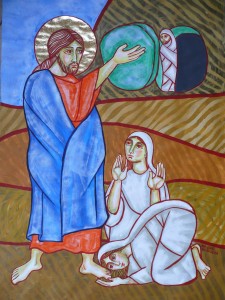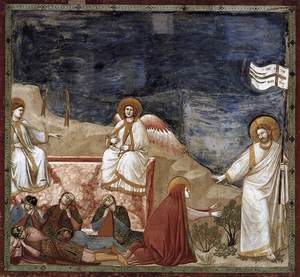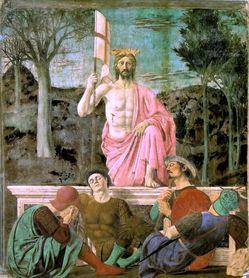 Dear brothers and sisters:
Dear brothers and sisters:
“And if Christ has not been raised, then empty is our preaching; empty, too, your faith. … You are still in your sins” (1 Corinthians 15:14,17). With these heavy words of the First Letter to the Corinthians, St. Paul makes clear how decisive is the importance that he attributes to the resurrection of Jesus. In this event, in fact, is the solution to the problem that the drama of the cross implies. On its own, the cross could not explain Christian faith; on the contrary, it would be a tragedy, a sign of the absurdity of being. The Paschal mystery consists in the fact that this Crucified One “was raised on the third day, according to the Scriptures” (1 Corinthians 15:4) — thus testifies the proto-Christian witness.
Here is the central key to Pauline Christology: Everything revolves around this gravitational center point. The whole teaching of the Apostle Paul departs from and always arrives at the mystery of the One whom the Father has risen from the dead. The Resurrection is a fundamental fact, almost a previous basic assumption (cf. 1 Corinthians 15:12), in base of which Paul can formulate his synthetic proclamation (“kerygma”): He who has been crucified, and who has thus manifested the immense love of God for man, has risen and is alive among us.
It is important to note the link between the proclamation and the Resurrection, just as Paul formulates it, and that which was used in the first pre-Pauline Christian communities. Here one can truly see the importance of the tradition that preceded the Apostle and that he, with great respect and attention, wanted in turn to convey. The text on the Resurrection, contained in Chapter 15:1-11 of the First Letter to the Corinthians, emphasizes well the nexus between “receive” and “transmit.” St. Paul attributes great importance to the literal formulation of tradition; the end of the fragment we are examining highlights: “Whether it be I or they, so we preach and so you believed” (1 Corinthians 15:11), thus spotlighting the unity of the kerygma, of the proclamation for all believers and for all those who would announce the resurrection of Christ.
The tradition to which he unites is the fount from which to draw. The originality of his Christology is never in detriment to fidelity to tradition. The kerygma of the apostles always prevails over the personal re-elaboration of Paul; each one of his arguments flows from the common tradition, in which the faith shared by all the Churches, which are just one Church, is expressed.
And in this way, Paul offers a model for all times of how to do theology and how to preach. The theologian and the preacher do not create new visions of the world and of life, but rather are at the service of the truth transmitted, at the service of the real fact of Christ, of the cross, of the resurrection. Their duty is to help to understand today, behind the ancient words, the reality of “God with us,” and therefore, the reality of true life.
Here it is opportune to say precisely: St. Paul, in announcing the Resurrection, does not
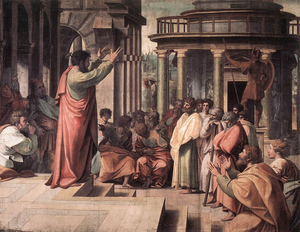 concern himself with presenting an organic doctrinal exposition — he does not want to practically write a theology manual — but rather to take up the theme, responding to uncertainties and concrete questions that are posed him by the faithful. An episodic discourse, therefore, but full of faith and a lived theology. A concentration of the essential is found in him: We have been “justified,” that is, made just, saved, by Christ, dead and risen, for us. The fact of the Resurrection emerges above all else, without which Christian life would simply be absurd. On that Easter morning something extraordinary and new happened, but at the same time, something very concrete, verified by very precise signs, attested by numerous witnesses.
concern himself with presenting an organic doctrinal exposition — he does not want to practically write a theology manual — but rather to take up the theme, responding to uncertainties and concrete questions that are posed him by the faithful. An episodic discourse, therefore, but full of faith and a lived theology. A concentration of the essential is found in him: We have been “justified,” that is, made just, saved, by Christ, dead and risen, for us. The fact of the Resurrection emerges above all else, without which Christian life would simply be absurd. On that Easter morning something extraordinary and new happened, but at the same time, something very concrete, verified by very precise signs, attested by numerous witnesses.
Also for Paul, as for the other authors of the New Testament, the Resurrection is united to the testimony of those who have had a direct experience of the Risen One. It is about seeing and hearing not just with the eyes and the ears, but also with an interior light that motivates recognizing what the external senses verify as an objective datum. Paul therefore gives — as do the four Evangelists — fundamental relevance to the theme of the apparitions, which are a fundamental condition for faith in the Risen One who has left the tomb empty.
These two facts are important: The tomb is empty and Jesus really appeared. Thus is built this chain of tradition that, by way of the testimony of the apostles and the first disciples, would reach successive generations, up to us. The first consequence, or the first way to express this testimony, is preaching the resurrection of Christ as a synthesis of the Gospel message and as the culminating point of the salvific itinerary. All of this, Paul does on various occasions: One can consult the Letters and the Acts of the Apostles, where it can always be seen that the fundamental point for him is being a witness of the Resurrection.
I would like to cite just one text: Paul, under arrest in Jerusalem, is before the Sanhedrin as one accused. In this circumstance in which life and death are at stake, he indicates the meaning and the content of all his concern: “I am on trial for hope in the resurrection of the dead” (Acts 23:6). Paul repeats this same refrain often in his Letters (cf. 1 Thessalonians 1:9ff, 4:13-18; 5:10), in which he invokes his personal experience, his personal encounter with the resurrected Christ (cf. Galatians 1:15-16; 1 Corinthians 9:1).
But we can ask ourselves: What is, for St. Paul, the deep meaning of the event of the resurrection of Jesus? What does he say to us 2,000 years later? Is the affirmation “Christ has risen” also current for us? Why is the Resurrection for him and for us today a theme that is so determinant?
Paul solemnly responds to this question at the beginning of the Letter to the Romans, where he makes an exhortation referring to the “gospel of God … about his Son, descended from David according to the flesh, but established as Son of God in power according to the spirit of holiness through resurrection from the dead” (Romans 1:3-4).
Paul knows well and he says many times that Jesus was the Son of God always, from the moment of his incarnation. The novelty of the resurrection consists in the fact that Jesus, elevated from the humility of his earthly existence, has been constituted Son of God “with power.” The Jesus humiliated till death on the cross can now say to the Eleven: “All power on heaven and on earth has been given to me” (Matthew 28:18). What Psalm 2:8 says has been fulfilled: “Only ask it of me, and I will make your inheritance the nations, your possession the ends of the earth.”
That’s why with the resurrection begins the proclamation of the Gospel of Christ to all peoples — the Kingdom of Christ begins; this new Kingdom that does not know another power other than that of truth and love. The Resurrection therefore definitively reveals the authentic identity and the extraordinary stature of the Crucified: An incomparable and most high dignity — Jesus is God! For St. Paul, the secret identity of Jesus, even more than in the incarnation, is revealed in the mystery of the resurrection. While the title “Christ,” that is, “Messiah,” “Anointed,” in St. Paul tends to become the proper name of Jesus and that of Lord specifies his personal relationship with the believers, now the title Son of God comes to illustrate the intimate relationship of Jesus with God, a relationship that is fully revealed in the Paschal event. It can be said, therefore, that Jesus has risen to be the Lord of the living and the dead (cf. Romans 14:9 and 2 Corinthians 5:15) or, in other words, our Savior (cf. Romans 4:25).
 All of this carries with it important consequences for our life of faith: We are called to participate from the depths of our being in the whole of the event of the death and resurrection of Christ. The Apostle says: We “have died with Christ” and we believe “that we shall also live with him. We know that Christ, raised from the dead, dies no more; death no longer has power over him” (Romans 6:8-9).
All of this carries with it important consequences for our life of faith: We are called to participate from the depths of our being in the whole of the event of the death and resurrection of Christ. The Apostle says: We “have died with Christ” and we believe “that we shall also live with him. We know that Christ, raised from the dead, dies no more; death no longer has power over him” (Romans 6:8-9).
This translates into sharing the sufferings of Christ, as a prelude to this full configuration with him through the resurrection, which we gaze upon with hope. This is also what has happened to Paul, whose experience is described in the Letters with a tone that is as much precise as realistic: “to know him and the power of his resurrection and (the) sharing of his sufferings by being conformed to his death, if somehow I may attain the resurrection from the dead” (Philippians 3:10-11; cf. 2 Timothy 2:8-12). The theology of the cross is not a theory — it is a reality of Christian life. To live in faith in Jesus Christ, to live truth and love implies renunciations every day; it implies sufferings. Christianity is not a path of comfort; it is rather a demanding ascent, but enlightened with the light of Christ and with the great hope that is born from him.
St. Augustine says: Christians are not spared suffering; on the contrary, they get a little extra, because to live the faith expresses the courage to face life and history more deeply. And with everything, only in this way, experiencing suffering, we experience life in its depth, in its beauty, in the great hope elicited by Christ, crucified and risen. The believer finds himself between two poles: on one side, the Resurrection, which in some way is already present and operative in us (cf. Colossians 3:1-4; Ephesians 2:6), and on the other, the urgency of fitting oneself into this process that leads everyone and everything to plenitude, as described in the Letter to the Romans with audacious imagination: As all of creation groans and suffers near labor pains, in this way we too groan in the hope of the redemption of our body, of our redemption and resurrection (cf. Romans 8:18-23).
In sum, we can say with Paul that the true believer obtains salvation professing with his lips that Jesus is Lord and believing in his heart that God has raised him from the dead (cf. Romans 10:9). Important above all is the heart that believes in Christ and in faith “touches” the Risen One. But it is not enough to carry faith in the heart; we should confess it and give testimony with the lips, with our lives, thus making present the truth of the cross and the resurrection in our history.
In this way, the Christian fits himself in this process thanks to which the first Adam, earthly and subject to corruption and death, goes transforming into the last Adam, heavenly and incorruptible (cf. 1 Corinthians 15:20 – 22:42-49). This process has been set in motion with the resurrection of Christ, in which is founded the hope of being able to also enter with Christ into our true homeland, which is heaven. Sustained with this hope, let us continue with courage and joy.
Pope Benedict XVI
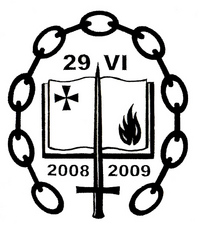 Wednesday Audience
Wednesday Audience
November 2, 2008
Courtesy of Zenit.org
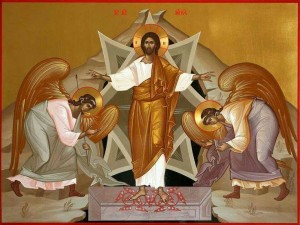 Easter Monday brings with it a new emphasis changing the old into new: old leaven is out, and new leaven brought in; new gifts recognized and offered to the Lord for the work of building up the Church. “Clear out the old yeast, so that you may become a fresh batch of dough.” (I Corinthians 5:7) Easter Monday is the second day of a new beginning.
Easter Monday brings with it a new emphasis changing the old into new: old leaven is out, and new leaven brought in; new gifts recognized and offered to the Lord for the work of building up the Church. “Clear out the old yeast, so that you may become a fresh batch of dough.” (I Corinthians 5:7) Easter Monday is the second day of a new beginning.